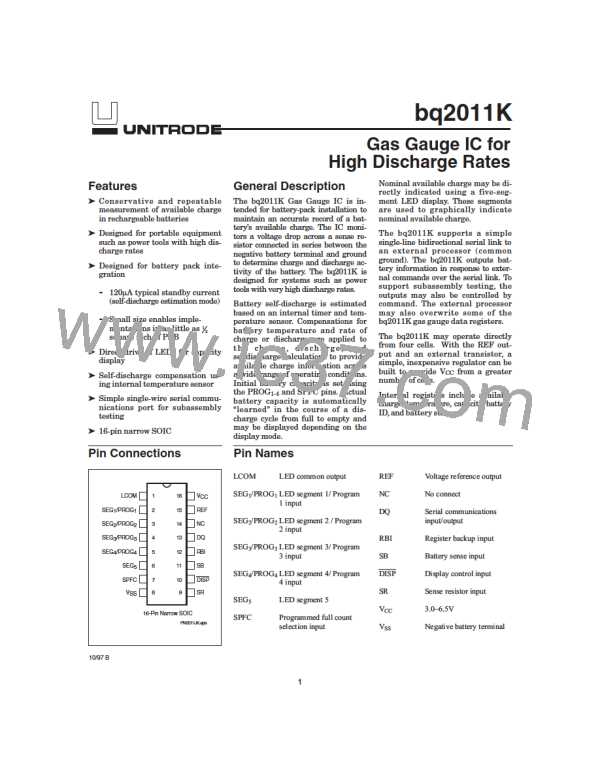bq2011K
4. Discharge Count Register (DCR):
Self-Discharge Estimation
The DCR counts up during discharge independent
of NAC and could continue increasing after NAC
has decremented to 0. Prior to NAC = 0 (empty
battery), both discharge and self-discharge incre-
ment the DCR. After NAC = 0, only discharge in-
crements the DCR. The DCR resets to 0 when NAC
= LMD. The DCR does not roll over but stops
counting when it reaches FFFFh.
The bq2011K continuously decrements NAC and incre-
ments DCR for self-discharge based on time and tem-
perature. The self-discharge count rate is programmed
1
to be a nominal
NAC rate per day or disabled per
80
*
Table 2. This is the rate for a battery temperature be-
tween 20–30°C. The NAC register cannot not be decre-
mented below 0.
The DCR value becomes the new LMD value on the Count Compensations
first charge after a valid discharge to VEDV if:
The bq2011K determines fast charge when the NAC up-
dates at a rate of ≥2 counts/sec. Charge activity is com-
pensated for temperature and rate before updating the
NAC and/or DCR. Self-discharge estimation is compen-
sated for temperature before updating the NAC or DCR.
No valid charge initiations (charges greater than
256 NAC counts; or 0.006 – 0.01C) occurred during
the period between NAC = LMD and EDV detected.
The self-discharge count is not more than 4096
counts (8% to 18% of PFC, specific percentage
threshold determined by PFC).
Charge Compensation
Two charge efficiency factors are used for trickle charge
and fast charge. Fast charge is defined as a rate of
charge resulting in ≥ 2 NAC counts/sec (≥ 0.15C to 0.32C
depending on PFC selections; see Table 1). The compen-
sation defaults to the fast charge factor until the actual
charge rate is determined.
The temperature is ≥ 0°C when the EDV level is
reached during discharge.
The valid discharge flag (VDQ) indicates whether
the present discharge is valid for LMD update.
Charge Counting
Temperature adapts the charge rate compensation fac-
tors over three ranges between nominal, warm, and hot
temperatures. The compensation factors are shown below.
Charge activity is detected based on a negative voltage
on the VSR input. If charge activity is detected, the
bq2011K increments NAC at a rate proportional to VSRO
(VSR + VOS) and, if enabled, activates an LED display
if VSRO < -2mV. Charge actions increment the NAC af-
ter compensation for charge rate and temperature.
Charge
Trickle Charge
Compensation
Fast Charge
Compensation
Temperature
<30°C
30–50°C
> 50°C
0.80
0.75
0.70
0.95
0.90
0.85
The bq2011K determines a valid charge activity sus-
tained at a continuous rate equivalent to VSRO < -400µV.
A valid charge equates to a sustained charge activity
greater than 256 NAC counts. Once a valid charge is de-
tected, charge counting continues until VSRO rises
above -400µV.
Discharge Compensation
Discharge Counting
Corrections for the rate of discharge are made by adjust-
ing EDV thresholds. The compensation factor used dur-
ing discharge is set to 1.00 for all rates and tempera-
tures. The recoverable charge at colder temperatures is
adjusted for display purposes only. See page 13.
All discharge counts where VSRO > 500µV cause the
NAC register to decrement and the DCR to increment.
Exceeding the fast discharge threshold (FDQ) if the rate
is equivalent to VSRO > 2mV activates the display, if en-
abled. The display remains active for 10 seconds after
VSRO falls below 2mV.
7

 TI [ TEXAS INSTRUMENTS ]
TI [ TEXAS INSTRUMENTS ]